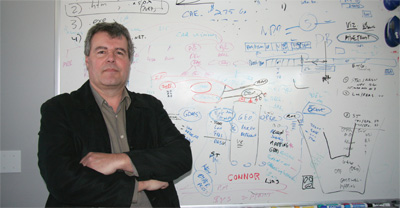 A new technology powerhouse is making its debut in the mining industry as a result of CAE Inc.’s recent acquisition of Datamine and Sudbury-based Century Systems Technologies. The acquisition brings together the simulation, modeling and data management technologies of the three companies under the banner of CAE Mining.
A new technology powerhouse is making its debut in the mining industry as a result of CAE Inc.’s recent acquisition of Datamine and Sudbury-based Century Systems Technologies. The acquisition brings together the simulation, modeling and data management technologies of the three companies under the banner of CAE Mining.
It could be a classic example of the whole being greater than the sum of its parts if the vision pans out.CAE Inc., a global leader in simulation systems and modeling technologies for the civil aviation industry and armed forces around the world, sees an opportunity to apply its expertise in industries that could benefit from simulation of virtual equipment operating in modeled environments.The ultimate objective is to leverage CAE’s simulation expertise to train operators of haul trucks, load-haul-dump machines, draglines and other sophisticated equipment in a safe and risk-free virtual environment.
“We can do a lot of things with simulators,” said Rod Baker, the Sudbury-based general manager of CAE Mining Canada. “We can bring in the operating environment because our modeling software already has that information in 3D space. This means we can train operators in (a representation of) the real environment they’ll be working in.”
Original equipment manufacturers are already using simulators, he said. “What CAE is looking to do is take it to the next level.”
The company should be ready to unveil simulator training for the mining industry within the next year or two, said Baker.
Beachhead
The Datamine acquisition in 2010 gave CAE a strategic beachhead in the mining industry.
“We were already established as a global technology leader in the industry and we had a global footprint working with the majority of the mining majors,” said Baker, who oversaw Datamine’s Sudbury-based Canadian operations and now fills the same role for CAE Mining.
Based in the U.K., Datamine also had offices in South Africa, India, Australia, the U.S., Chile, Peru and Brazil. The company markets a broad suite of software products for geological data management, resource and reserve management, ore evaluation, mine design and scheduling, and mine production.
The acquisition of Century Systems, a developer of geological data management systems for core logging, quality assurance and quality control, also made sense, said Baker.
“It was a natural fit for us to have Century Systems as part of the team because it gives us the ability to tightly integrate (the geological data) with all of the downstream processes that we have in the mining industry.”
CAE Mining’s Sudbury office started out in April 2010 with seven or eight Datamine employees and now has close to 35 staff, including 15 former Century Systems employees. By summer, Baker anticipates having 40 people onboard.
The growth in employment is attributable in part to the brisk pace of activity in the mining industry, but is also related to a broadening of the company’s consulting services.
“It’s very exciting for us because we have a hot mining industry and we have an owner that has the funds to support our initiatives at an accelerated pace,” said Baker. “CAE is a $1.6 billion company with a very aggressive approach to the mining industry. This is allowing us to further develop our software and expand the services we offer the mining industry.”
Processing costs
One area of software development the company is working on is the integration of processing costs into tools for orebody evaluation and planning.
“Traditionally, mining companies focused on the cost of extracting the ore out of the ground as efficiently as possible, but processing is also large component of their cost,” said Baker.
The objective is to allow mining companies “to understand the entire cost of that block of ore in the ground.”
For example, the tool would take into consideration different rock types and the amount of energy required for grinding.
“You may not get the proper fragmentation profile if you take a different type of rock through the same grinding circuit. What we can do is model the geology a little bit differently, allowing mine engineers to take a different extraction sequence,” said Baker. “Not only can they reduce the energy costs of grinding, they can also get the fragmentation profile they need for further processing down the road, and that will result in better recoveries.”
Montreal-based CAE is also planning to make several other acquisitions for its new mining division.
The company’s entry into the mining industry is in keeping with plans announced in April 2009 to spend C$274 million over seven years to expand beyond the aerospace sector.

